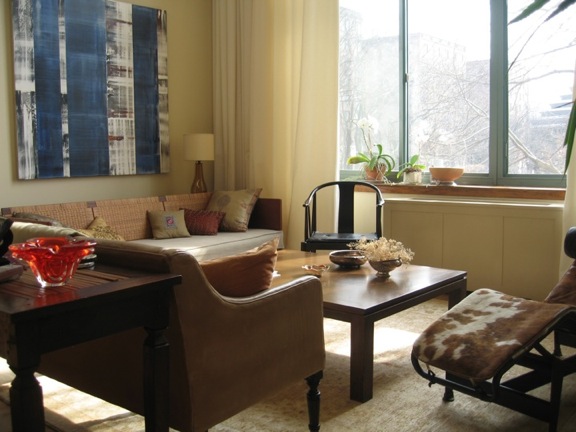
My husband, Anil, and I are great art lovers—not so much from an academic perspective, it’s more of a visceral thing for us. In other words, we know what we like when we see it. Still, it’s always interesting to learn about the ideas behind good art, so we’re lucky to have Sundaram Tagore as our friend. Sundaram represents some of the most talented contemporary artists in the world and enriches us with a generous dose of culture whenever we see him. I don’t think I’d be happy without art in my home, so we’ve acquired some of our favorite pieces from Sundaram, too. Recently, I asked him to share his thoughts on living with art. Here’s a portion of our conversation.
Jean: The work of all of the artists you represent is distinct, yet there’s a consistency in the spirit of their art. Is there a common thread that you look for in the work of the artists you represent?
Sundaram: I opened the gallery in 1999 with the idea of bringing together a global community of artists and galvanizing intercultural dialogue. Although I represent artists from a wide range of countries, such as Korea, Israel, Holland, Mexico, India and the United States, they are all linked by a similar philosophical view. Each artist shares a deep concern to harness art for the betterment of society. Moreover, each of these artists creates work for humanist purposes. Theirs is a quest for aesthetic beauty and spirituality. This has been a guiding force that has allowed me to bring together artists from such disparate places and create a cohesive vision for the gallery. Another common thread is their use of materials and the largely abstract nature of their work, which speaks to a universal audience.
Jean: When my husband and I acquired a work of art from you recently, both the color and scale of the piece were as important to me as the imagery and quality of the piece in the context of our home. Do you have advice for someone who is interested in collecting art to live with in their home?
Sundaram: Art has to do with aesthetics. Aesthetics are related to beauty. If you are surrounding yourself with beauty, you create a joyous environment and this leads to an overall sense of well-being. This isn’t mumbo-jumbo speak. Psychologists have done studies demonstrating that children who are raised with art are more sensitive in nature. Scientists have also proven that thoughts can change the very molecular structure of water. If you create a beautiful, positive environment then this would contribute to your thoughts being more balanced and positive. I believe that this eventually affects your behavior so that you would disseminate that positive energy around your neighborhood and the people you interact with. Hence, I would say that living with art would be a more integrated way of life. A well-balanced home leads to a well-balanced individual.
Moreover, it is not to be slighted that we as human beings have always created art since the pre-historic era. Art has existed for 40,000 years. We have a basic need to express ourselves in visual terms. It fulfills the realm of the imagination. The purpose of art is to inspire the soul, to make us think, and help us look at the world in new ways. The imagination is perhaps the only saving grace of human beings; this is what brings us closer to the notion of divinity.
Jean: Do you have recommendations on placement and hanging art in a residential environment?
Sundaram: The placement of art is generally based on color coordination, materials and light. Obviously one also has to think about the scale of the ceilings and the walls. All of the issues that a painter considers in the making of an artwork suddenly fall on us when we place an artwork in a home. We need to ask, how will one color will balance another color, for example? What would be the most advantageous position for the artwork so that it can speak for itself without being overwhelmed by surrounding furnishings? One has to understand that artwork on the wall generally tends to be one of a kind. Therefore it requires proper placement and stature within the household. I must say from what I have seen from my last visit to you home, you have both a sensitive and a bold taste—and so have created a truly beautiful home.
Jean: Your great-great uncle, Rabindranath Tagore was and continues to be perhaps India’s most well-known and respected poet and won the Nobel Prize for his work. He was also the contemporary and friend of Mahatma Gandhi and Jawaharlal Nehru. What did you learn from him about the role of art in everyday life?
Sundaram: My great-grand uncle was the first non-Western to win a Nobel Prize in literature. In fact, he was the one who gave the nomenclature of Mahatma to Gandhi and they were close friends. What I learned from my family is that art and culture are of paramount importance to life. Art and culture have the power to bring people together, which is why I formed this gallery based on intercultural dialogue. The mission of the gallery stems from my family’s intense interest in both local and international culture. They had a real anathema towards nationalism of any kind. Essentially, I learned that art has the power to humanize us and allows us to make sense of the world in which we live.
For more insight into the work of the artists Sundaram represents, visit his gallery’s Web site.




Thank you for this wonderful article! It has been extremely helpful. I hope that you will continue posting your knowledge with us.